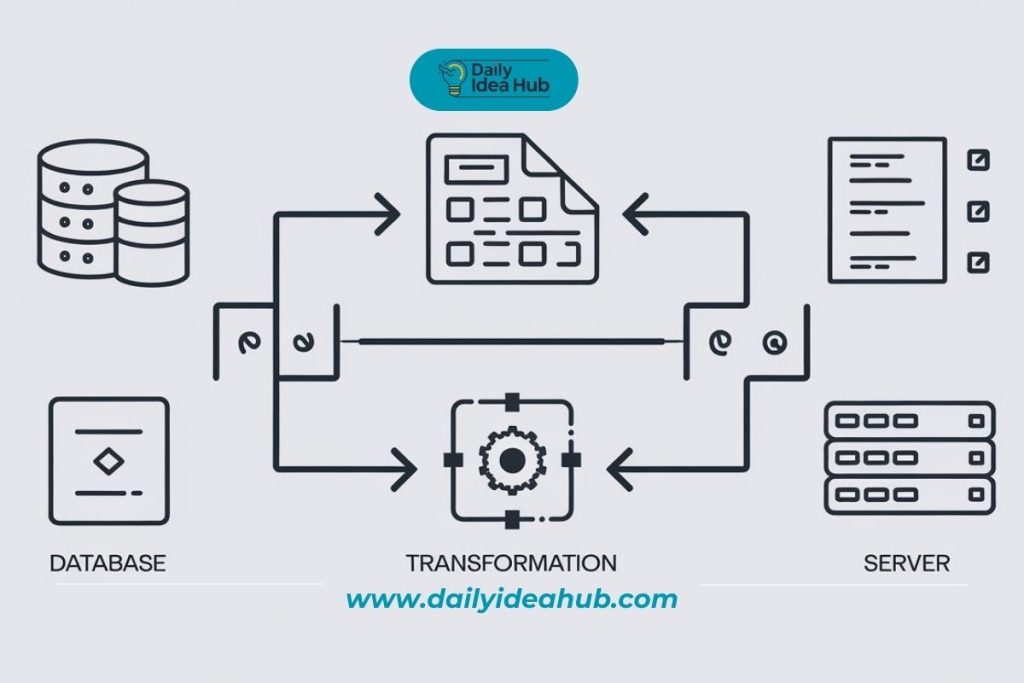
SQL Server Integration Services (SSIS) is a platform for creating enterprise-scale data integration and transformation solutions. SSIS is used for a variety of reasons, including data warehousing, data migration, and task automation such as email delivery and file processing. Among its numerous features, SSIS 816 is a crucial component that enhances data management and transformation capabilities. This article will go over the details of SSIS 816, including its features, benefits, and practical applications.
Table of Contents
What is SSIS 816?
SSIS 816 is an advanced component of SQL Server Integration Services that provides improved data management and transformation capabilities. It enables users to efficiently extract, transform, and load (ETL) data from multiple sources to destinations while maintaining data accuracy and consistency. With SSIS 816, organizations can streamline their data processes, improve data quality, and reduce manual efforts in data management.
Key Features of SSIS 816
- Data Integration: SSIS 816 includes powerful tools for merging data from various sources, including cloud services, flat files, and databases.
- Data transformation: It offers a wide range of transformation capabilities that enable users to aggregate, purify, and alter data as needed.
- Automation: SSIS 816 allows you to automate data-related operations, reducing the need for human contact.
- Error Handling: Advanced error-handling procedures ensure that any problems with data processing are effectively addressed.
- Performance Optimization: SSIS 816 is intended to process large volumes of data quickly and efficiently.
Benefits of Using SSIS 816
Implementing SSIS 816 in your data processes can bring numerous benefits to your organization:
- Improved Data Quality: SSIS 816 ensures that your data is accurate, consistent, and dependable.
- Increased Efficiency: Data management takes less time and effort because of automation and speed optimisation.
- Scalability: SSIS 816 can manage massive amounts of data, making it ideal for developing businesses.
- Cost-effective: SSIS 816 can result in significant cost savings by decreasing manual labour and increasing efficiency.
How SSIS 816 Works

Understanding how SSIS 816 works is critical for successful implementation in your data processes. This section will break down the process into manageable steps.
Step 1: Data Extraction
The SSIS 816 technique starts with data extraction. Pulling data from multiple sources, such as databases, flat files, and web services, is required for this. You may access data from anywhere in the world with SSIS 816’s support for a variety of data sources.
Step 2: Data Transformation
Once the data is extracted, the next step is transformation. SSIS 816 offers numerous transformation tools, allowing you to clean, aggregate, and modify the data as needed. Common transformations include:
- Data Cleansing: Removing duplicates, correcting errors, and standardizing data formats.
- Data Aggregation: summarizing data, such as calculating totals or averages.
- Data Modification: Changing data values, such as by converting currencies or updating records.
Step 3: Data loading
Data loading comes at last in the SSIS 816 process. This is getting the changed data to a location, say a database or data warehouse. By guaranteeing precise and fast data loading, SSIS 816 reduces the possibility of mistakes.
How SSIS 816 Ensures Data Integrity
Every data system depends critically on data integrity. Several tools in SSIS 816 help to guarantee that your data stays accurate and consistent all through the ETL process:
- Validation: SSIS 816 validates data at every phase of the process, ensuring early identification of any mistakes.
- Error Handling: Advanced error-handling systems let you swiftly control and fix problems.
- Data Auditing: SSIS 816 offers tools for data auditing, therefore enabling tracking of changes and monitoring of data quality.
Practical Applications of SSIS 816
SSIS 816 is a flexible instrument fit for several situations. SSIS 816 has the following useful applications:
Data Warehousing
SSIS 816 is used most often in data warehousing, among other things. SSIS 816 lets you enter data into a data warehouse from several sources, convert it into a consistent format. This helps companies combine their data into one location, therefore facilitating analysis and decision-making based on it.
Data Migration
Data migration also uses SSIS 816 somewhat frequently. SSIS 816 will enable you to rapidly and precisely migrate your data, whether you are combining data from many sources or updating to a new system. By guaranteeing an accurate data format for the new system, its sophisticated transformation tools reduce the possibility of mistakes.
Automating Data Processes
Automating data-related chores is yet another useful application for SSIS 816. SSIS 816 can help you, for instance, automate file processing, report sending, and database updating. This lowers the requirement for human involvement, therefore saving time and lowering the error risk.
SSIS 816 vs. Other Data Integration Tools
Regarding data integration, one finds numerous instruments at hand. In this section, a comparison with other well-known data integration systems will emphasize the benefits of SSIS 816.
SSIS 816 vs. Informatica
The popular data integration tool Informatica provides features like those of SSIS 816. SSIS 816 has a number of benefits, though:
- Cost: Generally speaking, SSIS 816 is less expensive than Informatica, so it’s a better option for companies on tighter budgets.
- Ease of Use: SSIS 816’s simple UI makes learning and using it simpler.
- Integration with SQL Server: SSIS 816 is completely connected with SQL Server, thereby enabling flawless data integration and management.
SSIS 816 vs. Talend
Talend is another data integration tool that competes with SSIS 816. Here are some key differences:
- Open Source vs. Proprietary: Though SSIS 816 is a proprietary product, Talend is open-source. Talend is so free to use; SSIS 816 provides more advanced capabilities and greater support.
- Performance: SSIS 816 is faster and more efficient than Talend since it is maximally suited for performance.
- Support: SSIS 816 has more thorough documentation and improved support than Talend.
SSIS 816 vs. Apache Nifi
Apache Nifi is a data integration tool that is often compared to SSIS 816. Here’s how they differ:
- Scalability: Since SSIS 816 is more scalable than Apache Nifi, it is a better fit for big companies.
- User Interface: SSIS 816’s simpler user interface helps one to operate it more easily.
- Integration with Microsoft products: SSIS 816 offers a more coherent data management experience by effortlessly interacting with other Microsoft programs.
Table: SSIS 816 vs. Other Data Integration Tools
| Feature/Tool | SSIS 816 | Informatica | Talend | Apache Nifi |
| Cost | Cost-effective | Expensive | Free | Free |
| Ease of Use | User-friendly | Moderate | Moderate | Moderate |
| Performance | High | High | Moderate | Moderate |
| Integration | SQL Server | Multiple | Multiple | Multiple |
| Scalability | High | High | Moderate | Low |
| Support | Strong | Strong | Moderate | Limited |
How to Implement SSIS 816 in Your Organization
Implementing SSIS 816 in your organization involves several steps. This section will guide you through the process.
Step 1: Assess Your Data Needs
The first step in implementing SSIS 816 is to assess your data needs. Determine what data you need to integrate, where it comes from, and how it needs to be transformed. This will help you design an effective SSIS 816 solution that meets your organization’s requirements.
Step 2: Design Your SSIS 816 Solution
Designing an SSIS 816 solution comes next once you have evaluated your data needs. This entails building data flows, defining transformation guidelines, and configuring error-handlers. With SSIS 816’s drag-and-drop interface, designing your solution is simple without requiring in-depth understanding of code.
Step 3: Test Your SSIS 816 Solution
You should test your SSIS 816 solution completely before putting it into use in a manufacturing setting. This entails verifying for any performance problems or mistakes running your data flows using sample data. Debugging features included in SSIS 816 help one to quickly find and fix any problems.
Step 4: Deploy Your SSIS 816 Solution
Implementing your SSIS 816 solution into your production environment comes last once you have tested it. SSIS 816 presents a number of deployment choices, including building a package capable of running on demand or assigning to a SQL server instance.
Step 5: Monitor and Maintain Your SSIS 816 Solution
Your SSIS 816 solution should be routinely monitored to make sure it is operating as expected following deployment. Monitoring capabilities included in SSIS 816 let you track your data flows’ performance and spot any anomalies. As your data changes with time, you could also have to change your SSIS 816 solution.
Frequently Asked Questions (FAQ) about SSIS 816
Q1: What is the main purpose of SSIS 816?
Answer: The main purpose of SSIS 816 is to provide advanced tools for extracting, transforming, and loading (ETL) data. It helps organizations efficiently manage and process data from various sources, ensuring data accuracy and consistency.
Q2: How does SSIS 816 differ from other versions of SSIS?
Answer: SSIS 816 provides better integration with SQL Server, advanced error handling, and superior performance optimization among other things. Large-scale data integration projects would find these characteristics more suited.
Q3: Can SSIS 816 be used for real-time data processing?
Answer: SSIS 816 can be set up for real-time data processing, indeed. It is appropriate for situations requiring up-to–date data accuracy since it includes capabilities enabling you to analyze data as it is acquired.
Q4: Is SSIS 816 suitable for small businesses?
Answer: SSIS 816 can be utilized by small firms even though it is best suited for big-scale data integration. Its simplicity of use and economy make it a reasonable choice for companies of all kinds.
Answer: SSIS 816 calls for a system running SQL Server with the memory and processing capability to manage the intended data volumes. It is advised to review the official material for particular system needs.
Q6: How can I learn to use SSIS 816 effectively?
Answer: Official material, online guides, and training courses abound to help one master SSIS 816. Practical experience working on sample projects also helps you become proficient with SSIS 816.

Conclusion:
Strong and flexible, SSIS 816 will let your company’s data management capacity be much improved. SSIS 816 provides the tools you need to reach your objectives whether your objectives are data quality enhancement, data processing simplification, or automation of mundane procedures. Any company trying to maximize the potential of their data will find SSIS 816 a great tool with its sophisticated tools, easy-to-use interface, and robust connection with SQL Server.
By understanding how SSIS 816 works, assessing your data needs, and following the implementation steps outlined in this article, you can successfully deploy SSIS 816 in your organization and reap the benefits of improved data management and efficiency.



